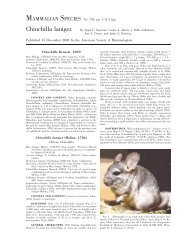Brugia Malayi - Clark Science Center - Smith College
Brugia Malayi - Clark Science Center - Smith College
Brugia Malayi - Clark Science Center - Smith College
You also want an ePaper? Increase the reach of your titles
YUMPU automatically turns print PDFs into web optimized ePapers that Google loves.
Generating Images of Swarming Motility Across Strains of Escherichia coli<br />
Shannon Pettit<br />
Swarm motility assays conducted as part of my honors project revealed differences in the swarming motility of E. coli across<br />
different strains, temperatures, and types of growth media. These analyses of motility provide a phenotypic comparison for gene<br />
expression data generated in the White-Ziegler laboratory. Recent microarray data from our lab has shown that genes involved in<br />
flagellar motility are down-regulated in a 37˚C to 23˚C transition for the non-pathogenic K-12 strain MG1655, while qRT-PCR data<br />
indicates that those same genes show increased expression after a 23˚C to 37˚C upshift. These gene expression patterns are not<br />
conserved across strains, where uropathogenic strain CFT073 demonstrates decreased motility gene expression after a 23˚C to 37˚C<br />
temperature shift.<br />
To generate images that support the phenotypic motility data, reduced-agar swarm motility plates were prepared and inoculated<br />
with the three strains of interest and a negative control. Images were taken of these plates at specific times after inoculation. These<br />
images were taken with illumination from below with indirect white light in a covered environment to minimize glare.<br />
These images support our previous findings that there are differences in motility based on strain and environmental conditions<br />
that include ambient temperature and the nutrient richness of the growth media. Uropathogenic strain CFT073 was motile in<br />
all media and temperature conditions, while enteropathogenic strain E2348/69 and K-12 strain MG1655 are more sensitive to<br />
environmental conditions. These two strains show high levels of motility on nutrient rich media, but minimal or no motility on a<br />
nutrient poor medium (Figure 1).<br />
The importance of these images is how they support the previously generated swarm motility data described in my honors<br />
project, which I presented in poster form at the American Society of Microbiology 2012 Annual Meeting in San Francisco, CA.<br />
They will be used in a publication alongside the data to further describe the effects of ambient temperature shifts on the gene<br />
expression and morphology of E. coli. (Supported by the Blakeslee Fund in the Biological <strong>Science</strong>s)<br />
Advisor: Christine White-Ziegler<br />
2012<br />
42

















